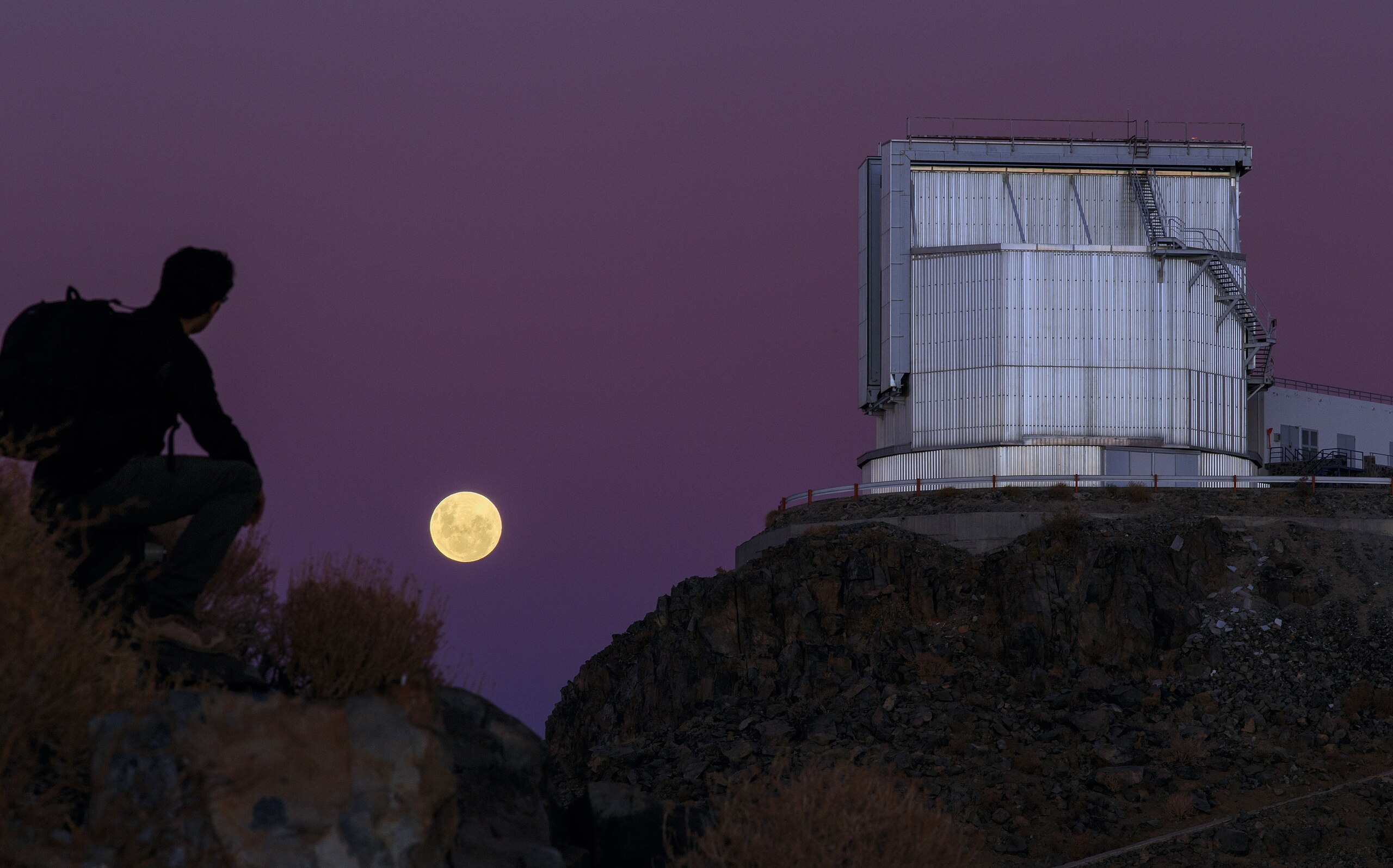

The Orbital Elements of Venus in Medieval Islamic Astronomy: Interaction Between Traditions and the Accuracy of Observations
by S. Mohammad Mozaffari

Reflections on Observational Astronomy in the Medieval Islamic Period authored by Dr. S. Mohammad Mozaffari is an essential volume in the history of astronomy shedding light on the comprehensive activities undertaken by Islamic astronomers in the realm of observational astronomy. It explores how these astronomers made observations, interpreted those results, and developed innovative methods to minimise empirical errors. In this book, Mozaffari examines how they derived new values for the astronomical parameters within Ptolemy’s framework, discovered new phenomena or identified hitherto-unknown peculiarities in Ptolemaic astronomy, and how and why they designed new instruments to advance their objectives.


This picture, taken at the La Silla Observatory in Chile, shows the full Moon low in the purple sky, a photographer (ESO/B. Tafreshi) crouching on the rocks, and the New Technology Telescope (NTT) perched on a hilltop. This image depicts the three things we need for observational astronomy: An object to observe, a telescope [or astronomical instruments] to observe it, and a person to make sense of the observations. (Wikipedia)
***
Review of “Reflections on Observational Astronomy in the Medieval Islamic Period” by S. Mohammad Mozaffari. Oxon: Routledge, 2025. Hardcover: 352 pages. ISBN: 978-1-032-77234-9.
Dr. Mohammad Mozaffari’s Reflections on Observational Astronomy in the Medieval Islamic Period is an extensively researched and carefully revised collection of chapters examining key aspects of observational astronomy during the medieval Islamic period (between the ninth to the seventeenth centuries). The chapters, originally published between the years 2012 and 2018, have been reworked to refine their accuracy and widen the scope of topics examined, which have been compartmentalised into five main sections in this volume.
This new publication critically explores a transformational stage in the history of Islamic astronomy, which began early in the ninth century. During this period, astronomers from diverse ethnic and religious backgrounds merged aspects from the occidental and oriental traditions, drawing from a rich body of textual and oral sources, as well as material culture. Despite the dearth of extant empirical records from the classical period (before 1050 CE), Mozaffari makes a strong case that experimental activities played a vital role not only in determining the conceptual framework that defined early Islamic astronomy, but also in the advancement of theoretical innovations later on.
With observational astronomy as a central theme throughout the volume, the book opens with a focus on solar astronomy in Part 1, presenting an extensive study on how Islamic astronomers calculated fundamental solar parameters. In Part II: Lunar Astronomy and Theory of Eclipses, Mozaffari continues with a detailed examination of lunar astronomy, exploring the shifting perspectives on annular solar eclipses, while highlighting a unique historical account in 1283 CE when one such event was predicted and observed. In Part III, the section on Planetary Astronomy, Mozaffari analyses empirical discoveries that differentiate the motion of apogees from the precession of the equinoxes, including major improvements to Ptolemy’s parameters for planetary latitudes. Part IV focuses on stellar astronomy, featuring a non-Ptolemaic star table that comprises observations spanning from ninth-century Baghdad to thirteenth-century Marāgha. The last section, Part V: Observational Instrumentation, investigates observational instruments, more specifically those created towards the second period of activity at the Marāgha observatory. A central focus of this section is a thorough examination of the observational practices that were employed at both the Marāgha and Istanbul observatories.


Figure 2. Ottoman astronomers at work around Taqī al-Dīn at the Istanbul Observatory 1574-1595 (Wikipedia)
In the volume, Mozaffari examines the interwoven relationship between observation and theory in the history of Islamic astronomy, beginning with gathering new quantitative data from observations, moving on to calculating the fundamental Ptolemaic parameters in astronomy, to the advancement of innovative theories in Islamic astronomy. The entire process laid the foundations for a re-evaluation of earlier observation-based theories, the revelation of new anomalies, the development of new concepts and original hypotheses on celestial motions, and the acknowledgement of hitherto unknown phenomena. Medieval astronomers responded to the challenges they encountered in their observations by developing innovative methods, formulating original strategies, and inventing novel instruments.
What makes Reflections on Observational Astronomy in the Medieval Islamic Period a vital resource is the synthesis of technical and textual evaluation of the Islamic astronomical corpus. The volume is thoughtfully crafted, weaving a sustained and detailed analysis of astronomical, historical, and conceptual elements for all topics explored. Mozaffari emphasises that historians of science must strive to do more than just textual translation and editing, or rendering the exact sciences through the prism of social and historical events; there is a need to directly engage with the technicalities of what astronomers actually did in the medieval Islamic period, which he skilfully accomplishes in this volume.


Figure 3. Illustration of different phases of the moon, from the manuscript of the Kitab al-Tafhim by Al-Biruni, 973-1048 (Wikipedia)
While acknowledging the complex array of historical perspectives (what Mozaffari refers to as “historical jigsaw puzzles”), as well as the paucity of biographical information on observational astronomers, in this volume Mozaffari uniquely draws attention to the contributions of some of the main astronomical figures in the medieval Islamic period, while highlighting the neglected contributions of more obscure figures. The intended audience of the book are subject specialists such as historians – particularly of astronomy – and scientists such as astronomers and physicists; however, Reflections on Observational Astronomy in the Medieval Islamic Period is an essential volume for students and anyone with an interest in the evolution of the exact sciences, the nature of experimental activities in medieval astronomy, and the historical interconnectedness of theory and observation.


5 / 5. Votes 1
No votes so far! Be the first to rate this post.




Muslim Heritage:
Send us your e-mail address to be informed about our work.
This Website MuslimHeritage.com is owned by FSTC Ltd and managed by the Foundation for Science, Technology and Civilisation, UK (FSTCUK), a British charity number 1158509.
© Copyright FSTC Ltd 2002-2020. All Rights Reserved.
